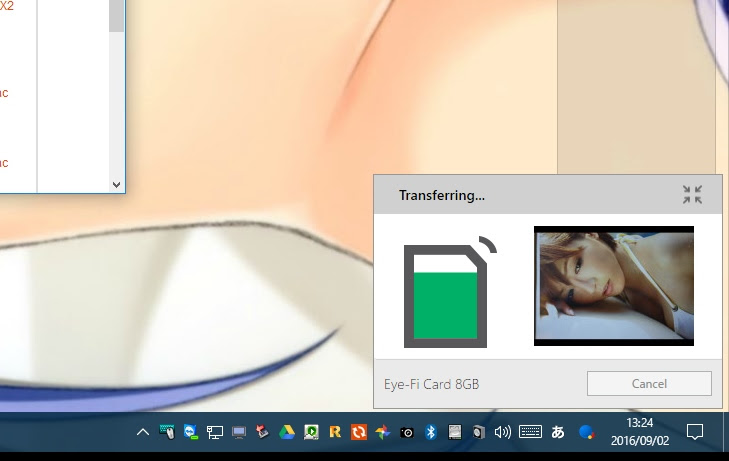
- #Eye fi x2 utility for mac os mac os x#
- #Eye fi x2 utility for mac os install#
- #Eye fi x2 utility for mac os download#
- #Eye fi x2 utility for mac os mac#
- #Eye fi x2 utility for mac os windows#
Just a thought.ħ) With the successful completion of step 6, the media card and the server are assured of their mutual authenticity. I am just wondering if there is anyway we can figure out the upload key from theĪbove equation. We can generate multiple values of this hash from multiple values of cnonce.
#Eye fi x2 utility for mac os mac#
Here mac address is known, cnonce is obtained using packet sniffing. Hash in the log file = MD5 ( cat (mac address, cnonce, upload key)) So essentially we will have a situation where: The cnonce that the card sends out canīe sniffed out using Wireshark. If there is a way to reverse engineer the key. MD5 of the concatenation of the mac address, cnonce and the upload key, I am wondering Given that the credential string from the server is the It says the credential string it was expecting from the server was this and what it With my eye-fi card, I see that it reports a credential mismatch. When you run the -l option through eyefi-config (eyefi-config -l > filename), it dumps Let's see if this one makes it this time. I had a quick bash trying to get the manager to run under wine so I could spy on the protocol, but after more than an hour of fighting wine the end wasn't in sight, so I moved onto other things.įor some reason my posts are getting deleted. It appears that the protocol between the manager and the card has changed enough that the tools no longer work. Ps: I would really have liked to get working the eyefi-config tools that Dave Hansen wrote but I simply couldn't get them to do anything beyond detect that there was a card in the USB adaptor. So now I have it all working on my linux fileserver When the camera comes into range and it's turned on, photos are automagically dropped into a spool directory, and a little daemon renames them into timestamped directories. (Which I did: I failed to get it to do anything useful when run under wine).
#Eye fi x2 utility for mac os windows#
The upload key that's required in the file is stored in Settings.xml if you've used the windows app manager to configure the card. I had a very quick poke, but the calculation wasn't immediately obvious to me so I wrote it off as a 'nice to have'.Ĭhanged file can be found here. The eye-fi card passes an MD5 sum along with the file on each upload, but it isn't a straight md5 of the tar file, nor of the embedded JPG file. Some minor changes include the server doing a fork for each client connect, and an unsuccessful attempt to verify that file checksum. Without this, the Eye-Fi refused to transfer more than one picture in a session. The other one is reflecting back the transfermode and transfermodetimestamp used in the session setup. Seems strange to me Not sure this isn't a bug in the Eye-Fi code. It's md5(mac addr, upload key, snonce) rather than the md5(mac address, cnonce, upload key) used in the other direction. It turns out that a different forumula is used to authenticate the client to the server. Fire up your camera, take a few shots, and the photos magically appear in the specified directory on your Linux machine.The two major changes are the certification calculation and the transfer mode. In the terminal, switch to the eyefiserver directory and execute the following command: python EyeFiServer.py -c DefaultSettings.ini Save the file and your server is ready to go.
#Eye fi x2 utility for mac os download#
Uncomment then the line that starts with DownloadLocation and specify the path to the directory where you want the server to download photos, for example: DownloadLocation=/home/user/Photos Open then the DefaultSettings.ini file and replace the default UploadKey value with your own.

Next, grab the latest version of the Eye-Fi server, unpack all files into a directory ( /home/user/eyefiserver). Once you've done that, open the Settings.xml file (on Windows XP, it's located in the C:\Documents and Settings\\Application Data\Eye-Fi directory) and note the UploadKey value.
#Eye fi x2 utility for mac os install#
On a Windows machine, install the Eye-Fi manager software and use it to configure your Eye-Fi card. This must be done in order to obtain the upload key required for the Eye-Fi server to function properly.
#Eye fi x2 utility for mac os mac os x#
You do need to have access to a Windows or Mac OS X machine to initialize your Eye-Fi card, though. Better yet, the server is extremely easy to configure and run.

Fortunately, the standalone Eye-Fi server written in Python will happily run on Linux, courtesy of the enterprising hacker Jeff Tchang.


The Eye-Fi card is a nifty solution for adding wireless capabilities to virtually any digital camera, but it does have one serious drawback: the card relies on proprietary software that runs only on Windows and Mac OS X.


 0 kommentar(er)
0 kommentar(er)
